Name Herbert Heinrich Role Safety engineer | Died June 22, 1962 | |
 | ||
Books Industrial accident prevention, Management and Controlling Employee Performance Similar Kenneth R Andrews, Peter Barnes (entrepreneur), Thomas R Jernigan | ||
Herbert William Heinrich (1886 – June 22, 1962 ) was an American industrial safety pioneer from the 1930s. He was an Assistant Superintendent of the Engineering and Inspection Division of Travelers Insurance Company when he published his book Industrial Accident Prevention, A Scientific Approach in 1931. One empirical finding from his 1931 book became known as Heinrich's Law: that in a workplace, for every accident that causes a major injury, there are 29 accidents that cause minor injuries and 300 accidents that cause no injuries. Because many accidents share common root causes, addressing more commonplace accidents that cause no injuries can prevent accidents that cause injuries.
Contents
- Heinrichs Theory Of Accident Causation In Hindi Heinrich Accident Pyramid HSE STUDY GUIDE
- Heinrichs Law Revisited
- References
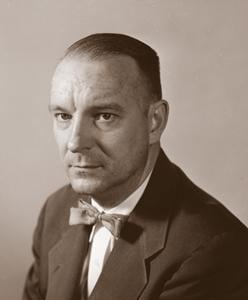
Heinrich's work is claimed as the basis for the theory of Behavior-based safety by some experts of this field, which holds that as many as 95 percent of all workplace accidents are caused by unsafe acts. Heinrich came to this conclusion after reviewing thousands of accident reports completed by supervisors, who generally blamed workers for causing accidents without conducting detailed investigations into the root causes.
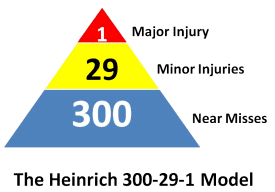
While Heinrich's figure that 88 percent of all workplace accidents and injuries/illnesses are caused by "man-failure" is perhaps his most oft-cited conclusion, his book actually encouraged employers to control hazards, not merely focus on worker behaviors. "No matter how strongly the statistical records emphasize personal faults or how imperatively the need for educational activity is shown, no safety procedure is complete or satisfactory that does not provide for the . . . correction or elimination of . . . physical hazards," Heinrich wrote in his book. Emphasizing this aspect of workplace safety, Heinrich devoted 100 pages of his work to the subject of machine guarding. Heinrich did safety work across many industries, with published data, which gives guidelines of how to scale up from incidents and near misses to a good estimate of the probability of real accidents.
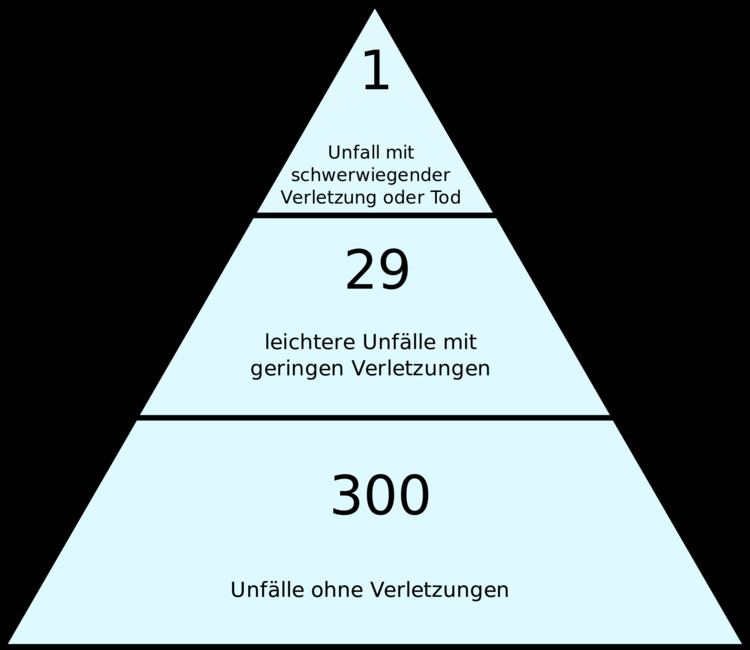
In 1961 he received the ASSE Fellow designation from the American Society of Safety Engineers.
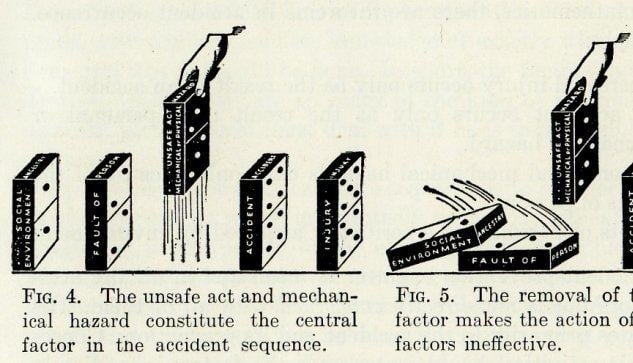
Heinrich died on June 22, 1962, at the age of 76.
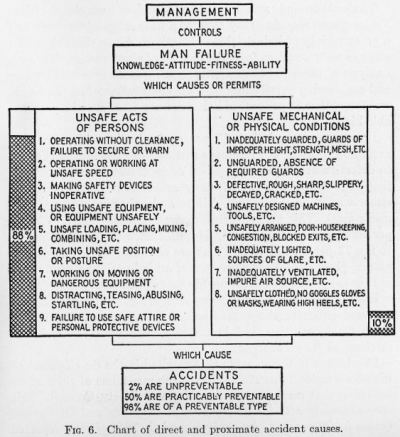
Heinrich's classic work has been revised into the more recent book,
Roos, Nestor R.; Heinrich, H.; Brown, Julienne; Petersen, Dan; Hazlett, Susan (1980). Industrial accident prevention: a safety management approach. New York: McGraw-Hill. ISBN 0-07-028061-4.
Heinrich's Theory Of Accident Causation In Hindi | Heinrich Accident Pyramid | HSE STUDY GUIDE
Heinrich's Law Revisited
Two later books challenge the findings and conclusions of Heinrich.
"Heinrich Revisited: Truisms or Myths" by Fred A. Manuele, CSP, PE [2002, ISBN 0-87912-245-5 published by National Safety Council offers the following in the last chapter. "The intent of this book is to present a review of the origin of certain of Heinrich's premises that became accepted as truisms, how they evolved and changed over time, and to determine their validity. A summary of the observations made in this book follows.
1. Files pertaining to Heinrich's research do not exist. Thus, there is no material to review as the quality of research, or the analytical system used to arrive at his premises or their validity.
2. Heinrich's studies were made of accidents that occurred in the 1920s. Safety at work and the workplace itself have changed substantively since then, as evidenced by noteworthy reductions in accident experience in the past 70 years. Therefore, the current value and applicability of his conclusions should be questioned and researched.
3. Although psychology has a place in safety management, the emphasis Heinrich gave to it as being "a fundamental of great importance in accident causation" was disproportionate, and that overemphasis influenced his work considerably.
4. Heinrich's 88-10-2 ratios indicate that among the direct and proximate causes, 88 percent are unsafe acts, 10 percent are unsafe mechanical or physical conditions and 2 percent are unpreventable
5. The Foundation Of A Major Injury, the 300-29-1 ratios (Heinrich's triangle) is the least tenable of his premises.
6. Heinrich's often-stated belief that the predominant causes of no-injury accidents are identical with the predominant causes of accidents resulting in major injuries is not supported by convincing evidence and is questioned by several authors. Application of the premise results in misdirection since those who apply it may presume, inappropriately, that if they concentrate their efforts on the types of accidents that occur frequently, the potential for severe injury will be addressed.
7. No documentation exists to support Heinrich's 4-1 ratio of indirect injury costs to direct costs. Further, arriving at a ratio that is universally applicable is implausible.
8. In Principles of Accident Prevention, Heinrich place an inordinate emphasis on the unsafe acts of individuals as causal factors and gives insufficient attention to causal factors deriving from operating systems. It is this author's belief that many safety practitioners would not agree with Heinrich's premise that "man failure is the heart of the problem and the methods of control must be directed toward man failure."
9. In Heinrich's Accident Factors, prominence is given to causal factors deriving from ancestry and environment and to the faults of persons that allegedly derive from inherited or acquired faults, that is, inappropriate with respect to current societal mores....."
The later book, "On the Practice of Safety, Third Edition," by Fred Manuele [2003, ISBN 0-471-27275-2 published by John Wiley & Sons, Inc] further discusses Heinrich and compares and contrasts his finding with those of W. Edwards Deming.
